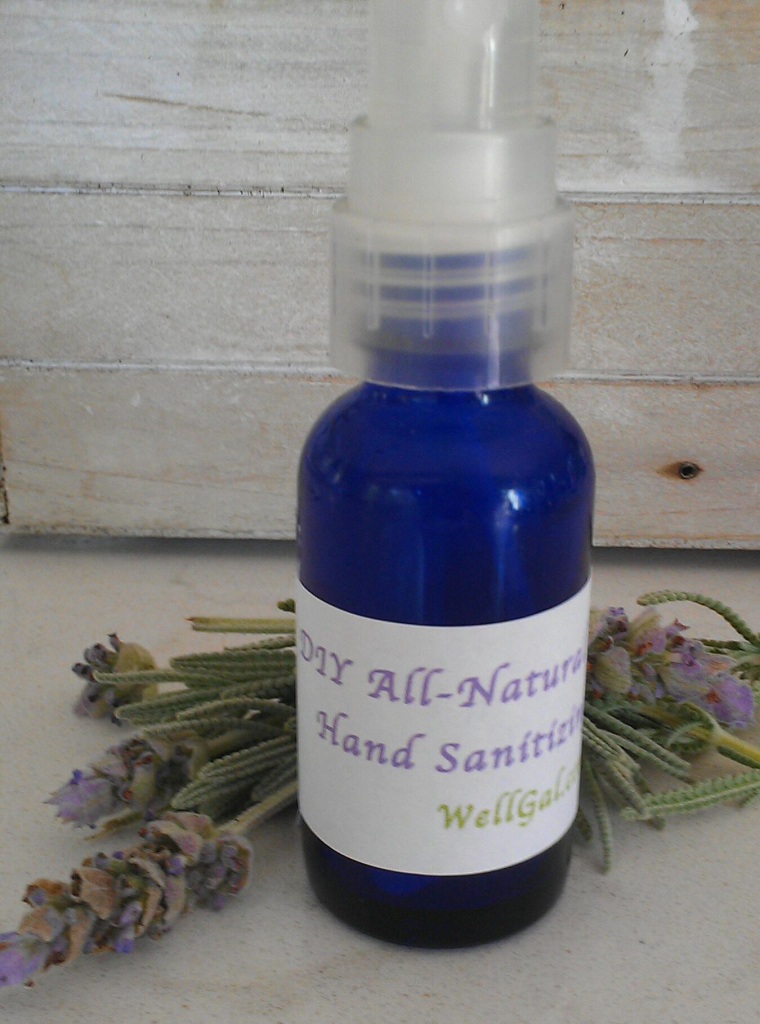
Learn how to make this all-natural and eco-friendly lavender hand sanitizer to protect yourself and your family from the coronavirus and other flu and cold germs.
Are you finding it difficult to find some decent hand sanitizer in light of the COVID-19 pandemic? I know I am. It seems that my whole family has gone through bottles of natural hand sanitizers from brands, such as EO, Everyday, and Dr. Bronner’s, almost as quickly as we have tissue! And at $3.99 a pop or so for a commercial 2-oz. product, they aren’t cheap, but they are soooo much better than the alternative–some of those nasty gel sanitizers made of synthetic chemicals full of ingredients that, well, really don’t seem to be that “clean” or safe for you, especially if used long-term. (See the section, “But First, Why Use Natural Hand Sanitizer?,” for more on that.)
Of course, in light of the current pandemic, I get why using any hand sanitizer you can is essential. But if you want to make your own, I want you to know you can and what the benefits are.
It’s super easy, quick, and much cheaper to make your own–and homemade products can be equally as effective as store-bought brands if you make them using the correct alcohol content. I’m going to share with you three great recipe options for hand sanitizer that has an alcohol content that meets U.S. Center for Disease Control (CDC) guidelines to combat COVID-19. It’ll also zap other flu and cold germs dead. Plus, at less than $1-2 per 2-ounce bottle, you can whip up a huge batch for family or friends. And you can modify the scent of it to your liking. So don’t worry if you’re not a lavender lover. I got other essential oil suggestions for you. Awesome, right?!
Let me show you how easy it is to make some, where you can get the ingredients and supplies, why the ingredients work and are effective, and how you can easily modify the scent and moisturizing properties. Plus, I’ll go into how to properly use hand sanitizer and some important warnings associated with it that you should check out.
Ready to get started? Great! Let’s go make some hand sanitizer!.
BUT FIRST, WHY USE NATURAL HAND SANITIZER?
Before launching into making your own hand sanitizer, maybe you’re wondering why you should make your own? And why does it matter if it’s natural?
Well, many of the conventional commercial brands contain artificial scents and colorants and chemicals like Triclosan, benzalkonium chloride, and phthalates.
- Artificial scents and colorants can cause skin sensitization and allergic reactions. So, who needs that in a product you and your loved ones, especially children, are needing to continuously use to protect themselves when out and about and hand washing isn’t an option?
- Triclosan used to be a problem ingredient in hand sanitizer, but it was finally banned on April 11, 2019, by the FDA as explained by Chemical and Engineering News in this article. Unfortunately, it’s still used in many other products as I talk about in detail in this blog post.
- Benzalkonium chloride is an alcohol substitute used in some popular brands’ (e.g., Germ-X and Purell) alcohol-free product versions notes Advisory.com in this article. However, when it comes to combatting the coronavirus, this ingredient is a problem as the CDC notes “available evidence indicates benzalkonium chloride has less reliable activity against coronavirus than either of the alcohols3.”
- Phthalates have many health concerns, such as harmful male reproductive effects, as noted in this Environmental Working Group (EWG) entry in its “Human Toxome Project” database. Plus, they have harmful environmental effects, such as getting into our water supply and negatively affecting other organisms, as explained in this article by ResearchGate.net, “Environmental Contamination With Phthalates and Its Impact on Living Organisms.”
- The CDC points out how, unfortunately, a lot of hand sanitizers result in accidental poisonings every year. This can be true for natural hand sanitizers, too, but I wanted to point it out nevertheless. More information on this is available in the “Warning!” section of this post.
When you make your own hand sanitizer, you have control over the ingredients.
- Vodka or grain alcohol is mostly made from natural, renewable resources. LiveScience.com explains how “most vodka is made from fermented grains such as sorghum, corn, rice, rye or wheat, though you can also use potatoes, fruits or even just sugar.” Everclear is made from a combination of GMO and non-GMO corn according to a brand manager at Luxco, the company that makes Everclear. So, obviously GMO isn’t ideal, but hopefully one day the company will move towards making it completely with non-GMO sourced ingredients.
- You can choose isopropyl rubbing alcohol if you don’t have access to vodka or Everclear or a stronger grain alcohol.
- If you have sensitivities or allergies to certain scents, you can modify the essential oils you use in your hand sanitizer–or completely leave them out. Artificial scents are made up of hundreds of synthetic chemicals sometimes, whereas essential oils are from plants. Plus, many of them have antimicrobial properties, so they serve a purpose in your hand sanitizer besides just smelling good.
- You can add natural moisturizing properties to your hand sanitizer, such as glycerin (a natural preservative and humectant), if you tend to get dry hands. Plus, you can control the amount you add as some people may need more, whereas others may prefer less.
- You get to leave out artificial colorants.
- There is no need to add in any other chemicals to make your hand sanitizer effective.
INGREDIENTS
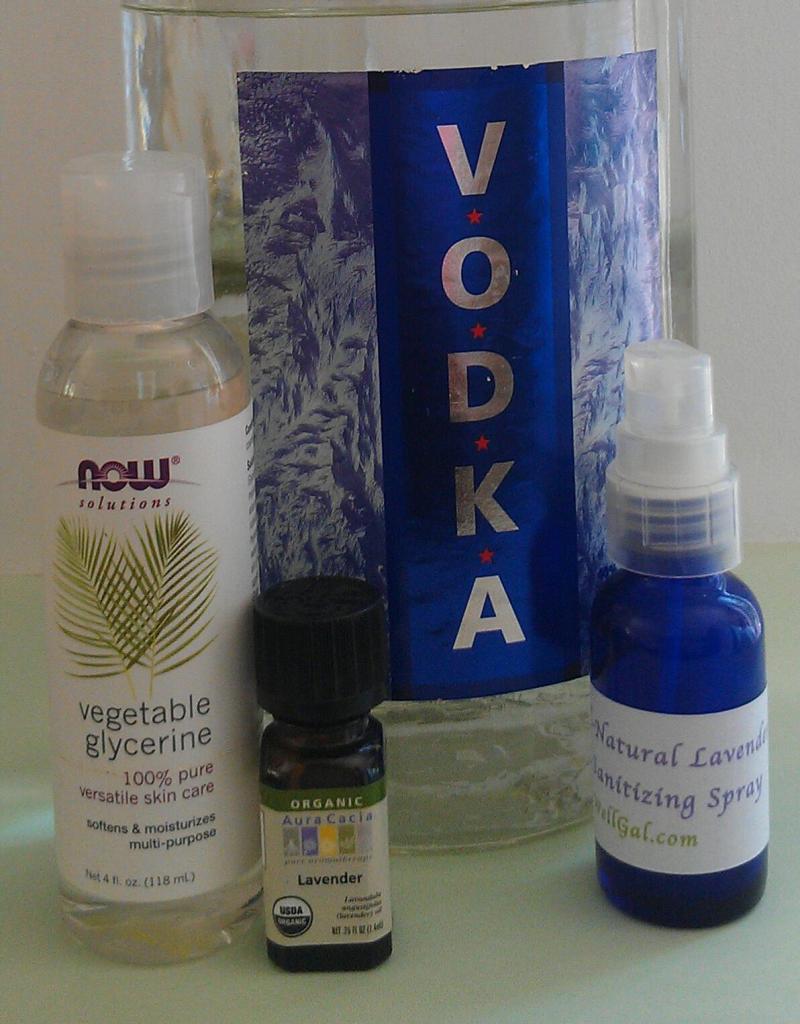
All it takes is just one simple ingredient and two optional ones to make an effective, germ-busting, but yet gentle on the skin, hand sanitizer: alcohol, lavender essential oil, and glycerin.
Because of the coronavirus, I’ve had to get real particular about how I go about describing how to make this hand sanitizer. Before COVID-19, I added in glycerin and essential oils without hesitation to 120-proof grain alcohol (ethanol), but because CDC guidelines for healthcare workers specifically indicate at least a 60% ethanol or 70% isopropanol alcohol content is needed (in the final product), that changed things. Also, after feedback from readers, I thought it important to give some options. I prefer grain alcohol over isopropanol for various health and environmental reasons, but I included both in case you can’t find one or the other. So, here are three options:
Option 1 – Scent-Free Hand Sanitizer With Just Alcohol
- 2 ounces (60 ml.) 120-proof vodka or grain alcohol (Everclear is my first choice, which is 60% ethanol) or 70% isopropyl rubbing alcohol (my second choice)
Option 2 – Hand Sanitizer with Just Alcohol and Essential Oils
- * 46.15 ml 91% isopropyl rubbing alcohol or 51.42 ml 140-proof grain alcohol (70% ethanol)
- **6 – 36 drops of lavender essential oil (Lavandula angustifolia) or other skin friendly blend (36 drops works out to approx. 1.9 ml; rounding to 2 ml. for simplicity for this recipe)
- 11.85 ml of distilled water if using 91% isopropyl rubbing alcohol or 6.58 ml of distilled water if using 140-proof or higher grain alcohol (70% ethanol).
Option 3 – Hand Sanitizer with Alcohol, Essential Oils, and Glycerin
- * 46.15 ml 91% isopropyl rubbing alcohol or 51.42 ml 140-proof grain alcohol (70% ethanol)
- **6 – 36 drops of lavender essential oil (Lavandula angustifolia) or other skin friendly blend (36 drops works out to approx. 1.9 ml; rounding to 2 ml for simplicity for this recipe)
- ***15 – 20 drops of vegetable glycerin. (20 drops of vegetable glycerin is approx. 1 ml)
- 10.85 ml of distilled water if using 91% isopropyl rubbing alcohol or 5.58 ml of distilled water if using 140-proof or higher grain alcohol (70% ethanol).
Makes about 2 ounces (60 ml.) of liquid hand sanitizing spray.
Very Important Notes Regarding Effectiveness Against COVID-19
*As adding essential oils will decrease the final alcohol concentration of this product, it’s safest to use at least 91% isopropyl rubbing alcohol it you want to achieve a final product with at least 70% isopropanol to meet CDC guidelines. Or, you can use 140-proof liquor to end up with a product that is at least 60% ethanol to comply with CDC recommendations.
**Lavender and many other essential oils have exhibited antiviral effects in past scientific studies, but no current studies have been done on them showing they combat COVID-19. Use at your own discretion and risk if you’re using a 120-proof liquor for your hand sanitizer. If you have access to a strong alcohol (e.g., 70% or higher ethanol content, which is 140-proof or more; or 91% isopropyl rubbing alcohol), it should be fine to use essential oils. See my discussion on isopropyl rubbing alcohol, which is often easy to find and is available with a 70% and 91% alcohol concentration, and make the best choice for yourself.
****Using glycerin and essential oils together is going to decrease the final alcohol concentration of your product. So, stick with a higher proof alcohol (e.g., 70% or higher ethanol content, which is 140-proof or more; or 91% isopropyl rubbing alcohol) to keep the final product alcohol concentration to at least 60% ethanol or 70% isopropanol.
OPTIONS
Instead of just lavender essential oil, you can also try blending it with some other essential oils, such as orange, bergamot, or grapefruit. Peppermint is also a great option as it is naturally revitalizing. Just be sure not to exceed the maximum drops indicated in the recipe. Essential oils are powerful and highly concentrated. Always start with less.
In place of distilled water, you could try some other ingredients. I’ve seen other recipes adding in aloe vera gel, aloe vera juice, or jojoba oil, which may add some more moisturizing components to the recipe. I haven’t tried them, though, and think maybe jojoba oil would clog up the sprayer. To be safe, I stuck with what Dr. Bronner’s hand sanitizer contains: just alcohol, water, glycerin, and essential oil.
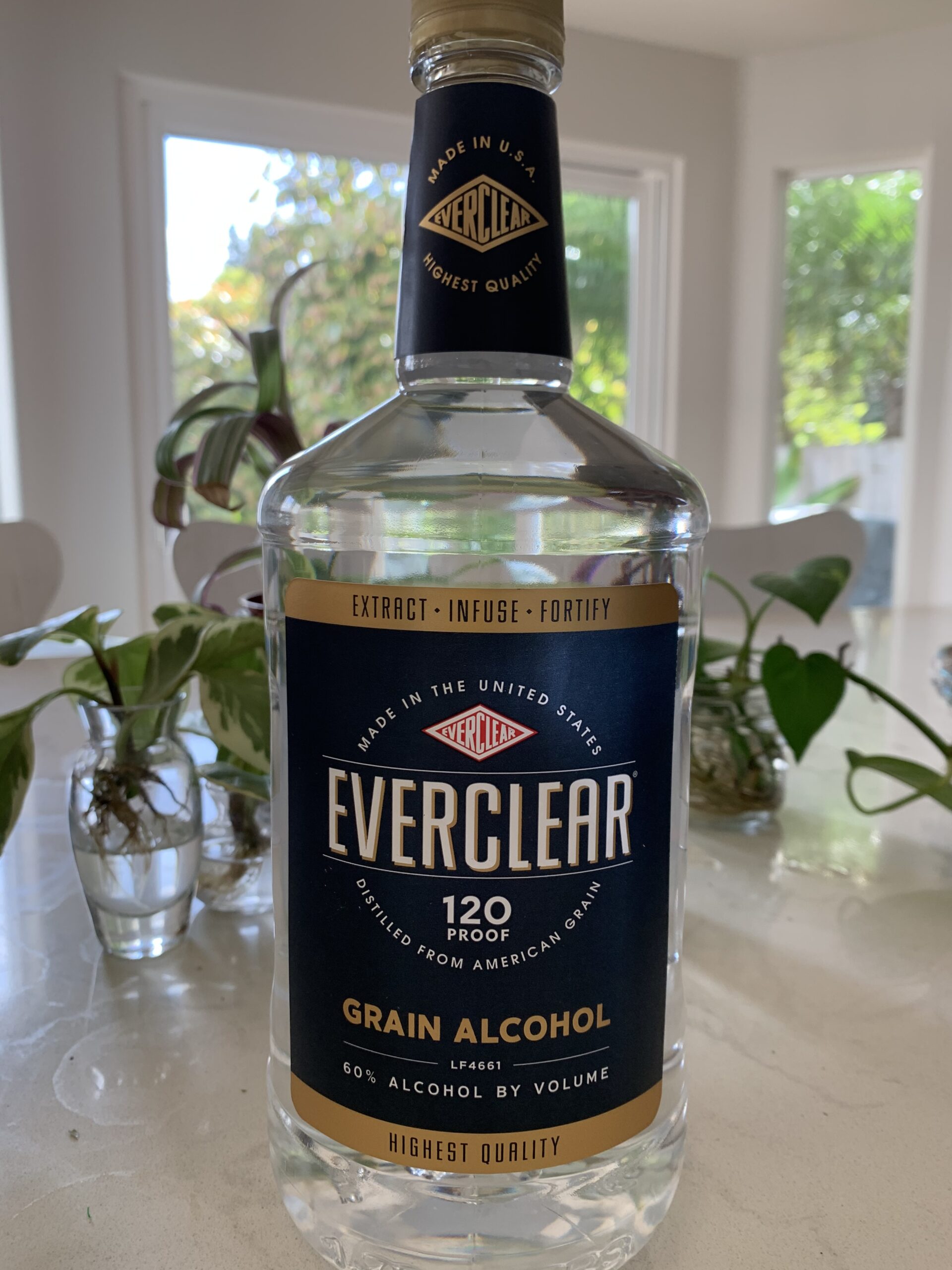
Use this 120-proof alcohol made from grains in sanitizing sprays. It contains 60% alcohol, so it meets CDC guidelines when used alone as a hand sanitizer.
WHY THE INGREDIENTS WORK
Alcohol
Now, I know what you’re thinking. You’re probably wondering why on earth I’m using vodka or a grain alcohol like Everproof. Well, because they’re alcohols, they have natural inherent antiseptic properties, so they’re fantastic at killing germs, especially cold and flu germs. In this article on hand hygiene for COVID-19, “CDC Statement for Healthcare Personnel on Hand Hygiene during the Response to the International Emergence of COVID-19,” the CDC “recommends the use of alcohol-based hand sanitizers with greater than 60% ethanol or 70% isopropanol.” So, if you use pure, undiluted 120-proof vodka or a 120-proof grain alcohol like Everclear (which is ethanol) with no additives of your own, you’re using 60% ethanol alcohol and thereby killing germs and protecting yourself. Same is true if you use 70% or higher rubbing alcohol. Anything less than that is not a guarantee.
Please do be aware as I noted above in the “Ingredients” section, that if you decide to add essential oils and glycerin into your hand sanitizer, you will be affecting the final alcohol concentration and therefore need to make sure you start out with an alcohol at a higher concentration than 60% or stronger than 120-proof. To be super safe, try the isopropyl rubbing alcohol, which is available at a 91% concentration, in many drug stores, or if you can find it, an alcohol that is at least 140-proof and 70% ethanol. If you try a higher alcohol content for this recipe, please do share your experience in the “Comments.”
The CDC does mention isopropanol as an alcohol that can be used in hand sanitizers, but it’s something I wouldn’t use in a spray hand sanitizer if I had a choice as I’d want to lessen the chance of breathing it in. Instead, I’d put it in a bottle with a cap, such as these ones you can find on Amazon. MSDSonline.com notes these health hazards for it: “Swallowing or inhaling isopropyl alcohol can cause headache, dizziness, vomiting, nausea, and unconsciousness. Long-term effects of working with this substance are not well-known at this time, so care and caution should be taken when handling isopropyl alcohol and isopropyl products as a preventative measure.” It’s also made from fossil fuels as Sciencing.com explains and has chemicals added to it to make it undrinkable notes ThoughtCo.com.
Incidentally, once you purchase vodka or Everclear, it has lots of interesting household and personal care uses and can be used to clean lots of things as I talk about in “10 Smashing Reasons to Give Vodka a Shot! (No Mixed Drinks Included).” So, once you crack open a bottle, you’ll be able to use it lots of ways!
Essential Oils
Lavender essential oil has long been used by aromatherapists for many of its healing properties, such as its antiseptic, antiviral, bactericide, fungicide, nervine, and sedative properties. It’s also safe to use on the skin and as the well-known aromatherapist Salvatore Battaglia says in his book, “The Complete Guide to Aromatherapy (2003 Ed.),” it is “nontoxic, nonirritating, and non-sensitising.” So, for those reasons, I consider it a great oil to use in hand sanitizers. It’s also powerful due to the unique combination of chemical constituents it contains. It has “camphor, terpinen-4-ol, linalool, linalyl acetate, beta-ocimene and 1,8-cineole,” according to the 2015 journal article, “Essential Oils Used in Aromatherapy, A Systemic Review.” These constituent concentrations and therapeutic effects can vary based on the species of lavender, the soil conditions, and the geographic location. So, when buying lavender essential oil, I buy it from reputable manufacturers. Also, when I make hand sanitizer, I tend to use Lavandula angustifolia.
No current studies have been done on the effectiveness of lavender or other essential oils against the coronavirus (i.e., COVID-19). However, several scientific studies have been done on essential oils and their antimicrobial properties, including antiviral effects, on other pathogens:
- In the 2019 article, “Essential Oils as Antimicrobial Agents—Myth or Real Alternative?,” published in the journal Molecules, the properties of lavender essential oil and many others (e.g., clove, cinnamon, peppermint, eucalyptus, etc.) are discussed in detail. Lavender’s antiviral properties have been shown to be effective against Herpes simplex virus type 1 and several studies have tested its antimicrobial properties in combatting Staphylococcus aureus (MRSA), E. coli (J53 R1), and more. The researchers also say how peppermint essential oil has showed high “virucidal activity against HSV-1 and HSV-2” and eucalyptus was also shown to have “100% inhibitory activity …against influenza virus A1/Denver/1/57 (H1N1) after 10 min exposure [35].”
- In this 2017 journal article, “Antibacterial, Antifungal, and Antiviral Effects of Three Essential Oil blends,” the researchers say how a blend containing eucalyptus and cinnamon essential oils with smaller amounts of rosemary, wild carrot, and camelina oils exhibited potent antiviral effects against H1N1 and HSV1.
- A 2014 study, “Anti-Influenza Virus Activity of Essential Oils and Vapors,” in the American Journal of Essential Oils and Natural Products discusses the antiviral activity of several essential oils, such as lavender, cinnamon leaf, geranium, sage, eucalyptus, red thyme, bergamot, and more. Many show potent antiviral effects; their effectiveness and the amount of time it took them to be effective varied depending on whether they were tested in a liquid or vapor phase.
- A 2010 study in the journal BMC Complementary Medicines and Therapies studied doTerra’s On Guard™, an essential oil blend consisting of “a mixture of wild orange, clove, cinnamon, eucalyptus and rosemary,” effectiveness on influenza in vitro on animal kidney cells. The researchers concluded: “Taken together, we found an essential oil blend notably attenuates influenza virus PR8 infection in vitro via inhibition of viral protein synthesis at the post-transcription level.” By the way, other brands on the market that have similar essential oil compositions are Plant Therapy’s Germ Fighter Synergy Blend and Young Living’s Thieves.
In “Holistic Nursing: A Handbook for Practice (Seventh Edition)” by Barbara Dosey, PhD, RN, the author points out that out of the commonly used essential oils, peppermint and tea tree are notable for their antiviral properties. Dosey notes how lavender is useful in nursing due to its “skin regenerative” and “calming” properties, amongst others. I’ve mixed lavender and peppermint together before in my hand sanitizer and it gives it a nice, uplifting scent.
By the way, if you do get some lavender essential oil for your hand sanitizer, you can also use it in DIY spa-at-home products (e.g., DIY Lavender Body Scrub), green cleaning recipes, (e.g., DIY Germ-Busting Aromatherapeutic Cleaning Scrub/Cleanser), and of course, for aromatherapy. Also, lavender essential oil is great for the skin. It won’t be something that just sits in your cupboard.
Glycerin
Glycerin acts as a natural preservative and humectant, meaning it draws moisture to the skin. Therefore, it helps counteract any drying action the alcohol may have. Both Dr. Bronner’s and EO’s hand sanitizers have glycerin in them and claim their products to be 99.9% effective, though they both have a 62% alcohol content; whereas if you just use 120-proof liquor with 60% alcohol, your final product will not be strong enough. Therefore, if you use glycerin, I urge you to make sure you use it with a strong alcohol, such as 91% rubbing alcohol or 140-proof grain alcohol (ethanol), so that the final alcohol concentration of your product is at least 70% isopropanol or 60% ethanol to meet CDC guidelines for effectiveness against the coronavirus.
WHERE TO PURCHASE INGREDIENTS & SUPPLIES
Vegetable glycerin, lavender essential oil, and empty glass or PET spray bottles are available at most natural grocery stores, such as Whole Foods Market, in the personal care section and many online retailers, such as Amazon.
Glass or PET Spray Bottles
Cobalt blue, dark green, or amber glass and PET plastic bottles are ideal because if you add essential oils to your hand sanitizer, they won’t break down the spray bottle material and the dark colored bottles will prevent the essential oils from degrading.
I like the fact that Amazon has lots of choices for spray bottles. You can find multipacks of 2 oz. bottles, which are ideal to make enough hand sanitizers for your friends and family. Some of them even come with labels and markers to make your creations look professional. There also some kits that contain various sized bottles, such as 2, 4, and 16 oz. bottles.
The 4 oz. spray bottles are ideal to make a room/air sanitizing spray, which is especially helpful if you have someone home at sick and need to sanitize the air, or is useful even at work when meeting with others during cold and flu season.
The 16 oz. bottles are amazing for making your own cleaning products, such as an all-purpose cleaning vinegar spray, this disinfecting DIY antimicrobial cinnamon cleaning spray for the bathroom or kitchen, or a disinfecting vodka spray.
Alcohol
Everclear should be available at most liquor stores. I found mine at BevMo. 120-proof vodka or a grain alcohol higher than 120-proof is something I couldn’t find at my local store recently. This Thrillist.com article lists some high proof spirit brands (stronger than 120-proof), including vodka, that are available for sale. So if you find some, please do share your experience with me and other readers in the “Comments” below. Isopropyl rubbing alcohol is available at pharmacies, many grocery stores, and usually on Amazon.
Beakers or Pipettes
To measure milliliters or drops, I’ve found using mini glass beakers or pipettes helpful. You can find find both on Amazon easily.
HOW TO MAKE YOUR OWN ALL NATURAL HAND SANITIZER
These steps are based on Option 3 in the “Ingredients” section. If you chose Option 1 or 2, just follow the steps that apply.
1. First, you need some containers to put your natural hand sanitizer in. Because I had a few empty EO and Dr. Bronner’s bottles laying around (got a junk drawer full of ’em), I simply reused those. But I wouldn’t reuse spray bottles from synthetic hand sanitizers. Instead, I’d use glass cobalt blue, green, or amber spray bottles as I described above. Also, before using them, wash them with warm soapy water, sterilize them and dry them.
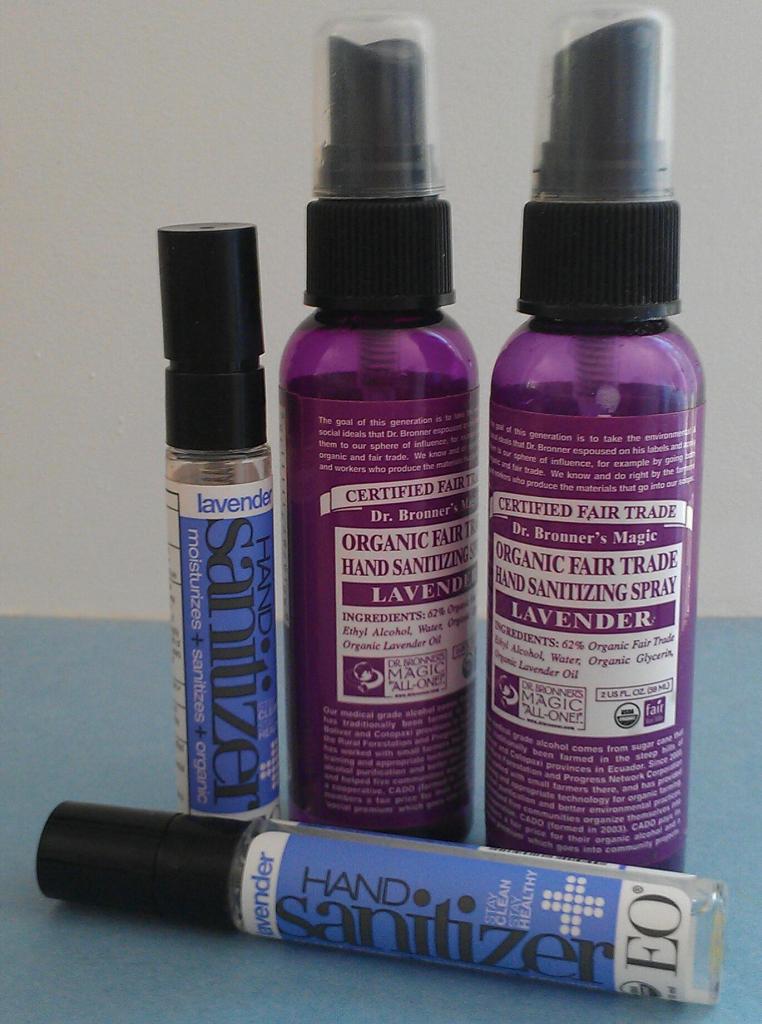
Recycle Dr. Bronner’s and EO Lavender Hand Sanitizer spray bottles to use for your own DIY natural hand sanitizers.
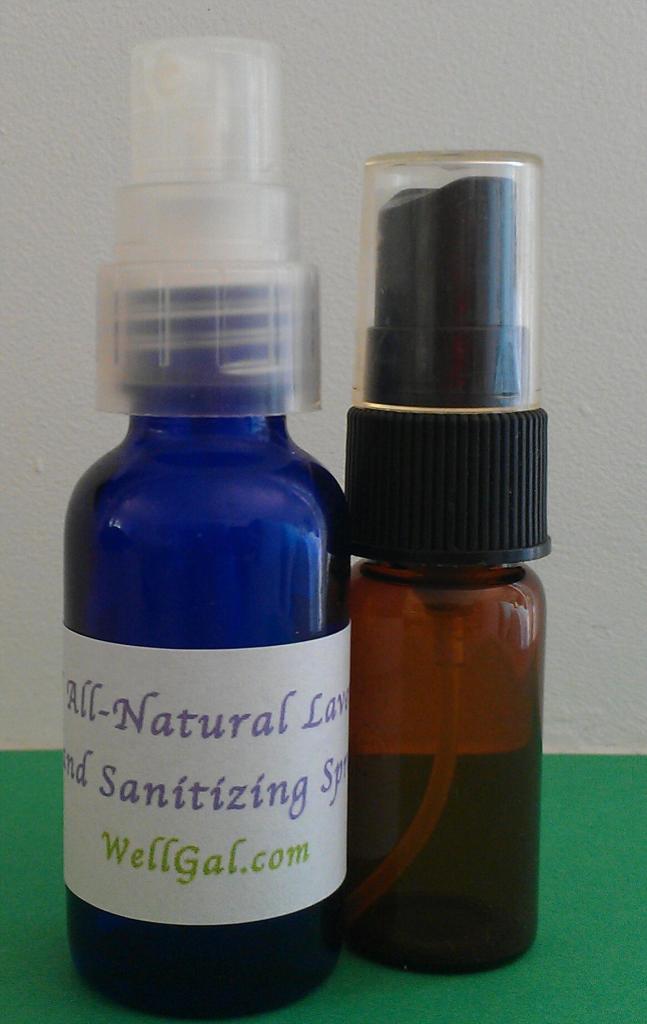
Glass cobalt blue and amber spray bottles, which are available in many different sizes, such as 1, 2, and 4 ounces, are another option to use for your non-toxic, homemade natural hand sanitizers.
2. Measure out the alcohol and pour it into your hand sanitizer bottle first, but don’t fill it up all the way if you are going to add essential oils and/or glycerin. For me, adding the alcohol first makes it easier to incorporate the essential oils. (I love using a mini glass beaker for measuring small amounts under 50 ml.)
3. Add in the essential oil drops. If making the hand sanitizer for children, the elderly, or pregnant women, use 6 drops to 12 drops of essential oil (a 0.5% to 1% dilution). Otherwise, use 36 drops, which is a 3% dilution. See ideas for essential oil scents besides lavender below in “Options.” Note: Measurements are based on there being approximately 20 drops of essential oil per ml.
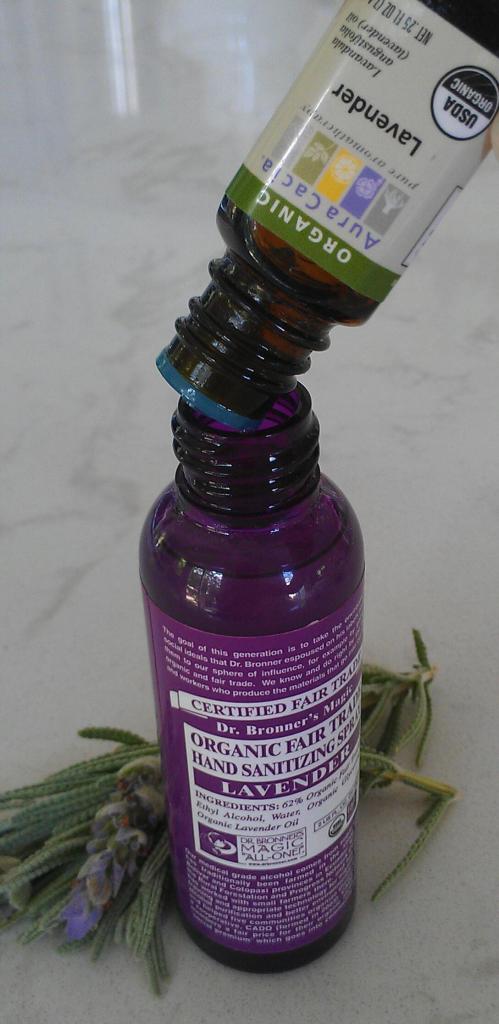
Tip: Tap the end of the lavender essential oil bottle to get the drops to flow easily when adding them into your spray bottle.
4. If desired, add in vegetable glycerin. Play around with proportions a bit as I found that depending on how dry your hands are to start with, you may prefer more or less of it. For example, I found about 15 – 20 drops of glycerin to be perfect, but my teenage daughter found it to be too much — probably due to that youthful beautiful skin of hers! So, if you find that your hand sanitizer leaves a sticky feeling on your skin, then you added in too much glycerin. Shake, cap, and test before adding more drops to get it to your liking.
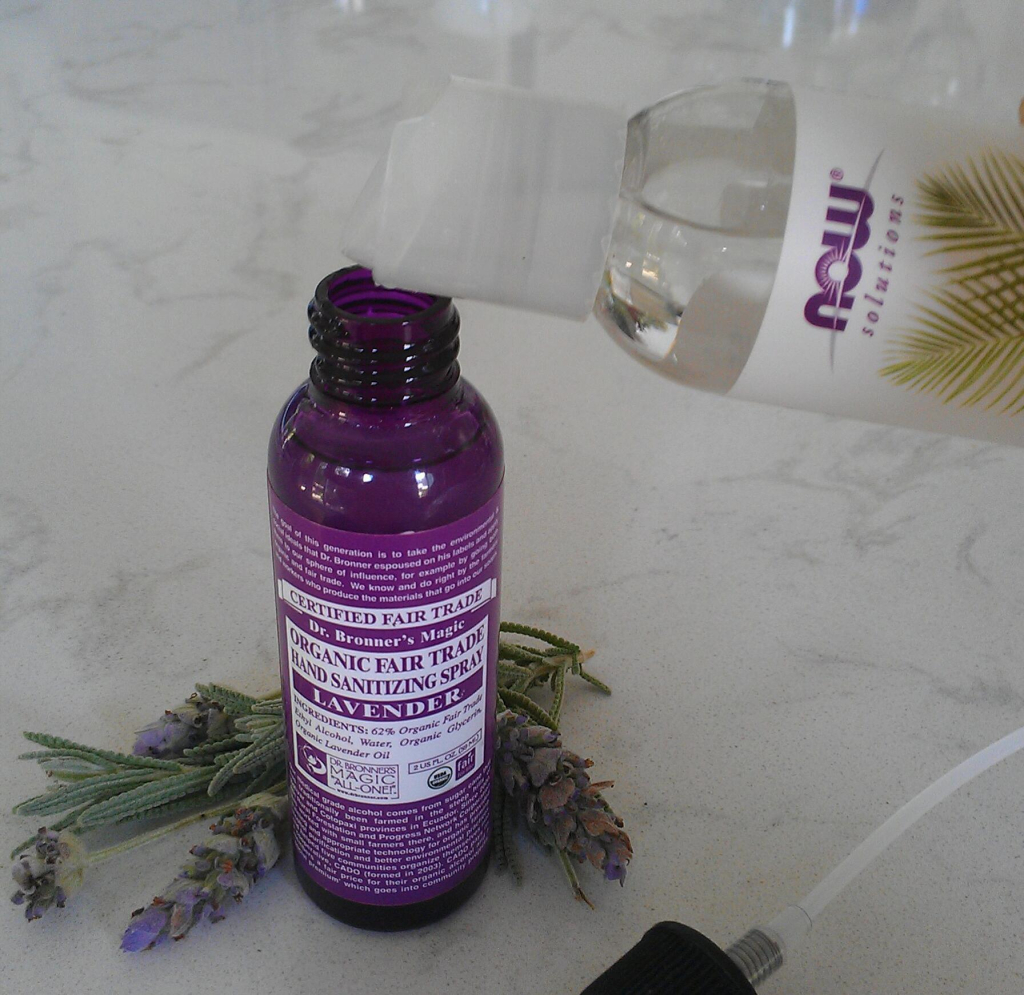
Don’t overdo the vegetable glycerin or your homemade hand sanitizer may feel “sticky” and it may take much longer to dry.
5. Add in distilled water if your version of the recipe requires it.
6. Close tightly and shake well. Voilà! You’re done!
TIPS
I found making a big batch of this recipe and storing the remainder in a tightly lidded, glass container out of reach from the kids, made frequent refills so much easier.
HOW TO USE
As the CDC notes, hand sanitizer is only effective when both hands, front and back, are thoroughly covered and you let your hands dry naturally versus wiping them dry. If your hands are soiled with grease or dirt to begin with, it may not be as effective. To be effective, a hand sanitizer with at “least 60% alcohol can help you avoid getting sick and spreading germs to others.” In addition, hand sanitizer may not remove certain chemicals, such as pesticides or heavy metals; in these cases, the CDC recommends washing with soap and water or following the directions of a poison control center.
WARNING!
In the article, “Show Me the Science — When & How to Use Hand Sanitizer in Community Settings,” the CDC talks about these warnings for commercial hand sanitizers:
“From 2011 – 2015, U.S. poison control centers received nearly 85,000 calls about hand sanitizer exposures among children 25. Children may be particularly likely to swallow hand sanitizers that are scented, brightly colored, or attractively packaged. Hand sanitizers should be stored out of the reach of young children and should be used with adult supervision. Child-resistant caps could also help reduce hand sanitizer-related poisonings among young children 24. Older children and adults might purposefully swallow hand sanitizers to become drunk 26.”
As the hand sanitizing recipe in this post contains alcohol and essential oils, keep hand sanitizer safely away and out-of-reach of children to prevent accidental consumption. If accidentally ingested, contact 911 or a poison control center. Poison.org contains phone numbers and other information on poison control centers. The American Association of Poison Control Centers is another resource; it suggests immediately calling the Poison Help hotline at 1-800-222-1222 and not to wait for symptoms to develop.
In addition, the CDC says this about the effectiveness of hand sanitizers:
“Soap and water are more effective than hand sanitizers at removing certain kinds of germs, like Cryptosporidium, norovirus, and Clostridium difficile1-5. Although alcohol-based hand sanitizers can inactivate many types of microbes very effectively when used correctly 1-15, people may not use a large enough volume of the sanitizers or may wipe it off before it has dried 14.”
As I discussed in this post, the CDC says that a hand sanitizer must be at least 60% ethanol alcohol or 70% isopropanol to be effective against the coronavirus. Many essential oils, such as lavender, have exhibited antiviral activity against some viruses in studies; however, essential oils have not been studied with regard to COVID-19 at the time this post was updated. Therefore, use lavender or other essential oils with a high enough alcohol concentration to begin with.
Likewise, glycerin may reduce the effectiveness of this hand sanitizer against COVID-19 if you don’t use it in the correct amounts and with a 140-proof ethanol or 91% isopropanol to begin with.
FINAL THOUGHTS
I put off making my own hand sanitizer for quite some time (even though I knew how to do it. I know, excuses, excuses!), but once I made it, I wondered why I hand’t done it sooner.
Have you had a chance to make this hand sanitizer or your own recipe? If so, please share your experiences or thoughts in the comments.
Also, please share this post on social media if you found it helpful. Thanks!
Note: The post was updated in July of 2015 and again on April 2 and 5, 2020.
Note: WellGal.com is a participant in the Amazon Services LLC Associates Program, an affiliate advertising program designed to provide a means for us to earn fees by linking to Amazon.com and affiliated sites.”
Copyright © Karen Peltier and Well Gal, 2014 – 2020. All rights reserved.
Photos © Karen Peltier and Well Gal, 2014 – 2020.
OTHER ARTICLES YOU MAY FIND BENEFICIAL
- 10 Smashing Reasons to Give Vodka a Shot! (No Mixed Drinks Included.)
- DIY Germ Busting Aromatherapeutic Cream Cleanser
- DIY Antimicrobial Cleaning Spray for the Kitchen and Bathroom
- Make This Powerful Antiseptic Room Spray to Keep Germs at Bay
- Top 3 Essential Oils to Disinfect the Air, Boost Immunity, and Treat Colds and the Flu
- “Which of These 10 Ways is the Best Way to Wash Your Produce?“
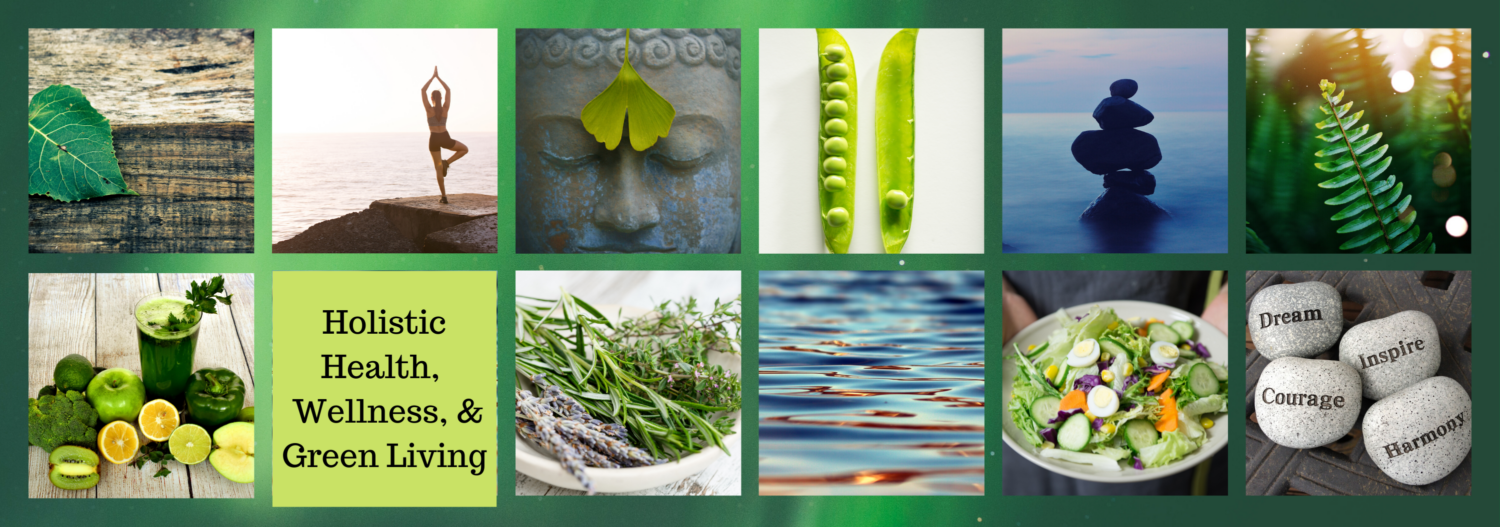
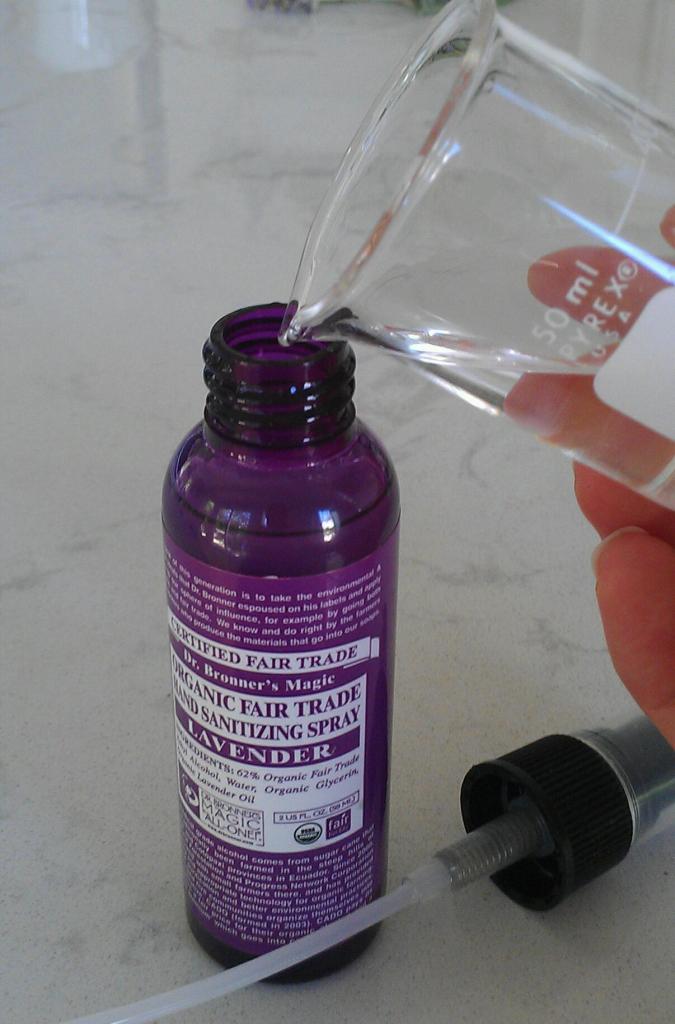
Alcohol is the best ever hand sanitizer that i have been using since last week.
60% alcohol will only work if you add nothing to it.
A 60% alcohol (at least) final content is the very least that will be of any use.
If you add anything then the resulting mixture is less than 60% alcohol and will not kill Covid-19.
You NEED to use at least 70% alcohol then the mixture has to be nine-tenths alcohol and one tenth aloe vera gel/glycerine/essential oils. This will give you 63% alcohol.
Easier still would be a 90% to a 99% alcohol which will be isopropyl alcohol or rubbing alcohol.
Then you can mix 2/3rd alcohol to 1/3rd aloe/glycerine/essential oils. This gives at least a 60% mix depending on your strength of alcohol.
Hi Darly.
Thanks so much for taking the time to leave a comment. I really appreciate it. In light of your feedback, I’ve modified my instructions to include three recipe options for people to make sure they are choosing what works best for them!
The CDC wants at least 60% ethanol or 70% isopropanol in the final product, so I indicated that at least 90% rubbing alcohol or a 140-proof ethanol would be needed if essential oils and glycerin is added. Otherwise, if someone uses no essential oils or glycerin, they can use pure 120-proof grain alcohol (ethanol) or 70% isopropanol. In general, I’m not crazy about rubbing alcohol for the reasons I describe in my blog post, but it’s important people know the options and how those options affect them.
Also, I added some information on essential oils and how past studies have shown they have antiviral effects. Of course, no current studies have been done on showing their effectiveness against COVID-19 specifically, but they are a nice addition to a hand sanitizer.
Thanks again and stay well!
Karen
I just did it and it’s very good! I love the texture and the smell. Thank you!
This is fantastic!! Just refilled my dr bonners bottle- i added 20 drops
Of glycerin- makes my hands feel
Soft- hope it won’t gum up
The spray piece.. and as an extra bonus if you are stranded and need more than just the scent of lavender; you can drink it!!
Hi instead of vodka can I substitute it with drug store rubbing alcohol?
Hi Kait,
Rubbing alcohol has poisonous chemicals added to it so you can’t consume it. I’m not sure having it in a fine-spray form would be a good idea due to the fact it can be poisonous when inhaled. So, I’d stick with vodka. It’s much safer.
Karen
Great recipe… remember that vodka is already a mix of water and alcohol. So a 100 proof bottle of alcohol is 50% water. Dr. Bronner’s is 62% alcohol, so you may want to skip adding any additional water to your formula!
Hello Susan.
Thanks for pointing out how a 100-proof bottle of vodka is already half water. Great catch! So you are right that using pure vodka may be all that is needed to get something similar in strength to the Dr. Bronner’s formula, which definitely will zap those germs dead.
Many aromatherapists use witch hazel in their sprays, which of course just has a fraction of alcohol in it, so I think it comes down to what you personally feel comfortable with.
Karen
I love Dr. Bronner’s hand sanitizer and was so excited to find your recipe. I could only find 151 proof vodka so I diluted it with distilled water. I found a fabulous website that tells you the exact dilution amount to add to make it a 60/40 dilution.The link is below.
http://homedistiller.org/distill/dilute/calc
Catherine
How wonderfully resourceful you are! My wife loves the smell of lavender. She uses lavender oil in her hair. Maybe there is a way to make your own hair treatment as well with home ingredients? I’m sure there would be a lot of people interested in that! Great read and instructions!
Hi Brandon.
Thanks for the nice complement. 🙂
There are definitely nice ways to make your own hair treatments with natural ingredients…You just gave me a good post idea. Thanks!
Karen
I think I quite like the idea of making my own hand sanitiser, especially if it contains Vodka 😉
I do love the bottles you use, I wonder if we can get similar ones in the UK?
Hi Sarah. I would definitely think that you should be able to find small aromatherapy spray bottles in the UK, especially since aromatherapy is much more embraced there as a complementary therapy than in the U.S. If you do find bottles, please let me know where you found them as I’m sure other UK readers would like to know.
Karen,
what a great incentives you give us here.. making our own natural sanitizer.. woww??? I never thought of it, thanks so much for sharing such a great recipe.. and by the way.. I will replace Vodka with pure alcohol.. but is ok for you to use it and drink it if you drink…hhahah
Lavender makes the whole thing worthwhile, the scent is so great.. I love it.
Thanks again, so much for sharing.
_nickc
Hi Nick.
Glad you enjoyed the recipe! I don’t drink vodka, but only use it for cleaning, herbal tinctures, and of course, in hand sanitizing sprays. 🙂 You mention you’d replace the vodka with pure alcohol. I’m curious. What kind would you use?
I’m wondering if Everclear would constitute “pure” alcohol? By the way Ive been searching for a Dr Bronner’s Hand Sanitizer clone! Thanks for the recipe 🙂
Hi Sharon.
I’m not familiar with Everclear and perhaps other readers aren’t, so I Googled it. It’s a corn-based alcohol with two proofs available — 151 and 190-proof, though perhaps not in every state according to Wikipedia. So, you may need to tweak the alcohol/water ratio depending on which proof you use. Let me know if you give it a try!
Karen
Hi ,
Due to the fact that my religion forbids the use of alcohol .What could I use instead of alcohol in the recipe?
Hi Zaheda. Some aromatherapists use a couple drops of pure lavender essential oil all by itself as a natural hand sanitizer, which of course is super simple! So you may wish to try than as an option for an alcohol-free hand sanitizer.
Lucky Me!
I have all the ingredients to make this hand sanitizer. If it wasn’t for recent visitors at my home, I would have to get the vodka…which I never drink! But a good thing I saved half that bottle for a rainy day!
I wrote down the ingredients and am looking forward to make it myself. I love working with essential oils. And Lavender is one of my favorites…I put a few drops in the bath all the time to relax.
Thanks so much…I rather DIY than purchase something I need to hunt down.
-Donna
Hi Donna.
Wonderful! Sounds like you’re all set to make yourself some hand sanitizer thanks to your recent visitors who made sure you’ve got some vodka on hand!
Let me know how it works out for you.
Karen
I tend to just wash my hands. If I don’t have a sink to wash them in, then I don’t eat or do anything with dirty hands unless I have soap and water. Most sanitizers irritate me. However, my sister loves this type of stuff so I’ll be sending her a link to this.
Hi Nile.
I’m absolutely on board with washing one’s hands instead of using hand sanitizer if there’s soap and water nearby! Studies have shown that proper washing with soap and water does a very effective job at removing germs and dirt.
So, for me, I tend to use my hand sanitizing spray when I can’t wash my hands, such as when I’m in the car. I also find it useful for general disinfecting. For example, I’ve used some on a napkin to wipe down my phone or computer keyboard and have even used it while traveling to disinfect those pull-down trays on airplanes.
Thanks for sharing the recipe with your sister. Social shares are always welcome! 🙂
Karen
I love the scent of lavender also, this sounds great, and easy to make! I wouldn’t tell your friends about this Karen, or you’ll end up in making it for everyone else as well.
Hi Julieanne.
I’m lucky in that I haven’t gotten an overwhelming number of “orders” from friends for this DIY lavender hand sanitizing spray! But, you know, it would be fun to make a large batch for the holidays coming up and give them away. They’d make great hostess gifts, stocking stuffers, etc….Oh my! Here I am talking about the holidays like the big brand names stores do and it’s not even the end of September!
Karen
Oh this sounds marvelous and I just love the scent of lavender. Thanks so much also for showing where the ingredients can be purchased. I’m glad to see most of them can be ordered online because I live on an Island and while we have the basics anything out of the everyday norm almost always has to be shipped in.
Hi Marquita. It really is so much nicer than the “standard” hand sanitizers on the market. I love the scent of lavender, too. It has a calming effect, so I love to use it when I’m on the go or having a particularly stressful day.
Also, I’m glad you noticed how most of the ingredients can easily be purchased on-line (the vodka might be tougher!), so hopefully you can get a hold of what you need if they aren’t available at your local store.
I work in the medical field and definitely use a lot of hand sanitizer. This is a pretty cool DIY set of instructions. I never thought about making my own hand sanitizer. I get a kick out of that because I am all for saving money. Thanks for sharing.
Hi Nathaniel. This definitely will save you money! I haven’t done the math to determine how many bottles of hand sanitizer you can make with one bottle of vodka, some essential oil, and water but I’m sure it’s dozens if not over a hundred. Thanks for taking the time to leave a comment.